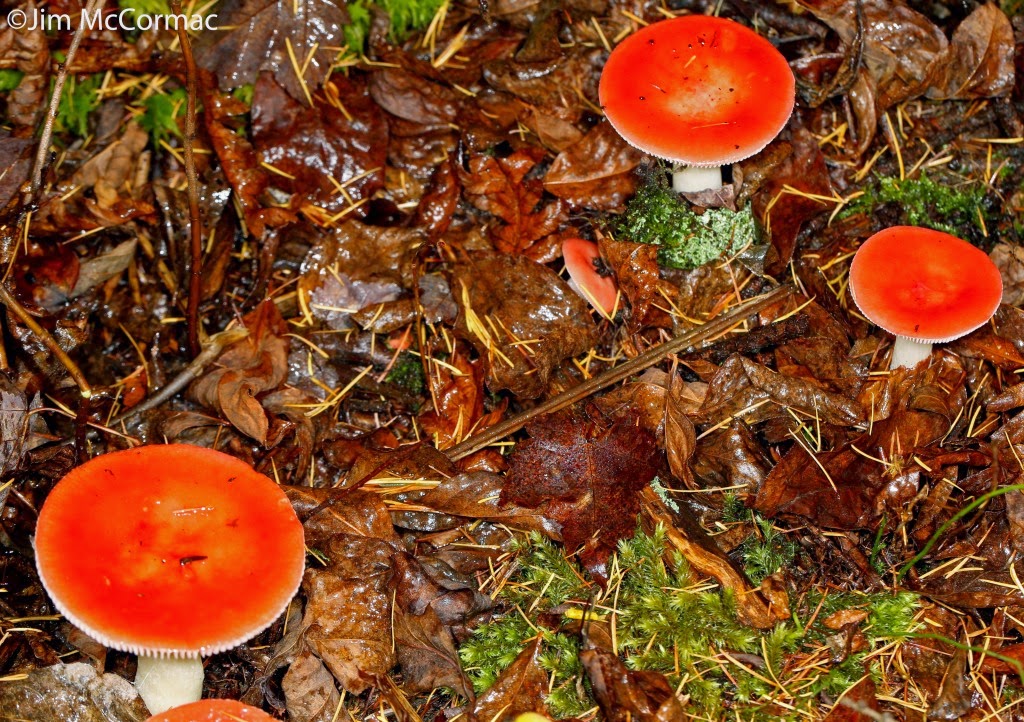On my recent foray through Kent Bog, written about HERE, I couldn't help to notice a multitude of colorful mushrooms. Nor could I resist going prostrate on the wet boardwalk to make images. I am not much of a mushroom expert, but find them irresistible photography subjects. I've got a large pile of mystery mushroom photos awaiting identification.
I do think I know the name of this blood-orange beauty. It is Russula emetica, and that scientific epithetic should tell you all you need to know about its edibility. Emetic comes from the Greek word emetikos, which means vomiting. My identification may well be incorrect; apparently Russula mushrooms are many, with lots of look-alikes. Let me know if you know better.
While nearly everyone would find these 'shrooms pleasing to the eye, probably no one would find them pleasing to the palate. Here are two of its common names: "The Sickener", and the "Vomiting Russula".
Not exactly the sort of fungus one is apt to put on the pizza.
Whatever you call it, the mushroom is certainly eye candy. They stood out like colorful beacons against the damp leaf litter underlying Kent Bog's tamarack forest; the brightest jots of color in the place on this cool late October day.
The underside of the showy cap was divided into a neat arrangement of gills.
Although it may have been natural deterioration - many mushrooms don't last that long in their fruiting body form - it looked as if something had been nibbling at the Russulas. Who, given their powerful emetic properties, would be so foolhardy?
I wonder if Eastern Box Turtles still survive in Kent Bog and its protected environs? These reptilian tanks are well known for their love of nasty and even downright deadly mushrooms. The turtles must have cast-iron constitutions. I once encountered a turtle in the act of scarfing down a "Vomiting Russula", but saw no evidence that the turtle hurled as a result. In fact, it had left a lengthy trail of ravaged mushrooms in its slow and plodding wake. Many mushrooms, like may-apples, grow at just the right height for a low-slung tortoise to notice, and harvest.
I do think I know the name of this blood-orange beauty. It is Russula emetica, and that scientific epithetic should tell you all you need to know about its edibility. Emetic comes from the Greek word emetikos, which means vomiting. My identification may well be incorrect; apparently Russula mushrooms are many, with lots of look-alikes. Let me know if you know better.
While nearly everyone would find these 'shrooms pleasing to the eye, probably no one would find them pleasing to the palate. Here are two of its common names: "The Sickener", and the "Vomiting Russula".
Not exactly the sort of fungus one is apt to put on the pizza.
Whatever you call it, the mushroom is certainly eye candy. They stood out like colorful beacons against the damp leaf litter underlying Kent Bog's tamarack forest; the brightest jots of color in the place on this cool late October day.
The underside of the showy cap was divided into a neat arrangement of gills.
Although it may have been natural deterioration - many mushrooms don't last that long in their fruiting body form - it looked as if something had been nibbling at the Russulas. Who, given their powerful emetic properties, would be so foolhardy?
I wonder if Eastern Box Turtles still survive in Kent Bog and its protected environs? These reptilian tanks are well known for their love of nasty and even downright deadly mushrooms. The turtles must have cast-iron constitutions. I once encountered a turtle in the act of scarfing down a "Vomiting Russula", but saw no evidence that the turtle hurled as a result. In fact, it had left a lengthy trail of ravaged mushrooms in its slow and plodding wake. Many mushrooms, like may-apples, grow at just the right height for a low-slung tortoise to notice, and harvest.





